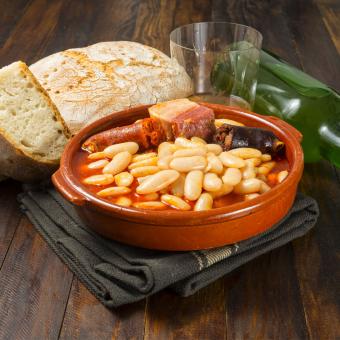
The Great Spanish Cook Book: Fabada Asturiana
Photo from Adobe Stock
Whilst you might not have heard of Fabada Asturiana, it’s likely that you’ve already enjoyed a version of this hearty and incredibly popular Spanish stew. Spaniards are incredibly proud of their rich cultural heritage, and that extends to the food and drink that they enjoy too. Fabada is a white bean and chorizo stew that originated in the Spanish region of Asturias. This dish is loaded with flavours and spices, and it is eaten across the country, particularly during the winter months where it serves as a warming dish accompanied by chunks of crusty bread.
Whilst the exact origins of Fabada Asturiana are unknown, we do know that it first appeared between the 19th and 20th centuries. To celebrate its Asturias roots, the dish is often enjoyed alongside a glass of Asturian cider. Ready to try your hand at making it yourself? Check out the recipe below:
Ingredients
450g white beans
Two Spanish chorizo
Two Spanish morcilla (black pudding/blood sausage)
One tsp salt
10-12 threads of saffron
Method:
- Prepare this step the day before you plan to eat your Fabada Asturiana. Remove any broken beans from your bowl, and then soak the beans in cold water overnight, until they are plump and ready to cook.
- Thoroughly prick both the chorizo and morcilla sausages
- Place the white beans, chorizos and morcilla sausages into a pan filled with cold water. Add a tablespoon of salt and then bring to the boil. Ensure that the sausages are at the top of the pan with the beans sitting underneath, and that all of the ingredients are covered by the water.
- Cover the pot with a lid, and then once it has reached a boil, turn it down to a simmer. Leave it to simmer at a low heat for 30 minutes.
- Skim any froth and fat from the top of the pan and the add two or three tablespoons of cold water. This should stop the pan from boiling, before you can cover the pot again and continue to simmer.
- Repeat steps 4 and 5 three more times, being sure to remove the fat and froth from the pan each time. Repeat the steps one final time, adding the saffron threads beforehand at this stage. This whole process should take two and a half hours in total: low and slow cooking will ensure the finished dish is as flavoursome as possible.
- Remove the chorizo and morcilla from the top of the pan and place it on a plate: slice the sausages into smaller chunks, then return to the pan and stir.
- Scoop the stew into small bowls and serve immediately. The dish is traditionally enjoyed as a main course, accompanied with crusty bread and Asturian cider.
Are you thinking of moving to Spain? Perhaps you like the idea of submerging yourself into the traditional Spanish lifestyle and cooking Spanish recipes every day? Whatever your dream, we can help. Why not get in touch with our team of local property experts today, to find out more about how we can help you.
